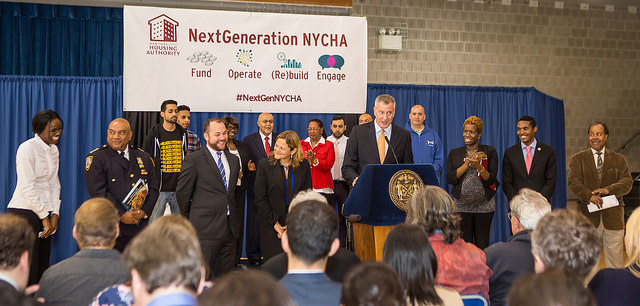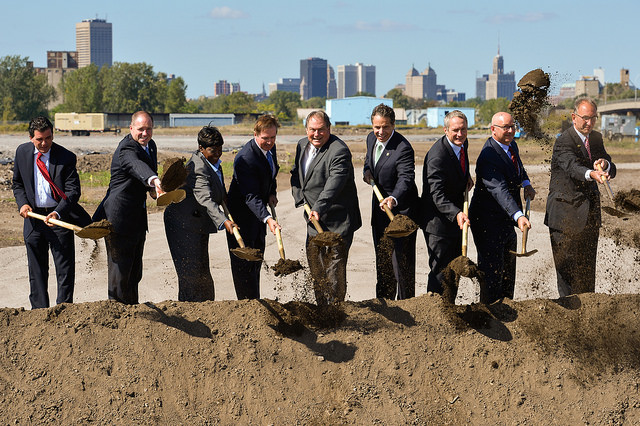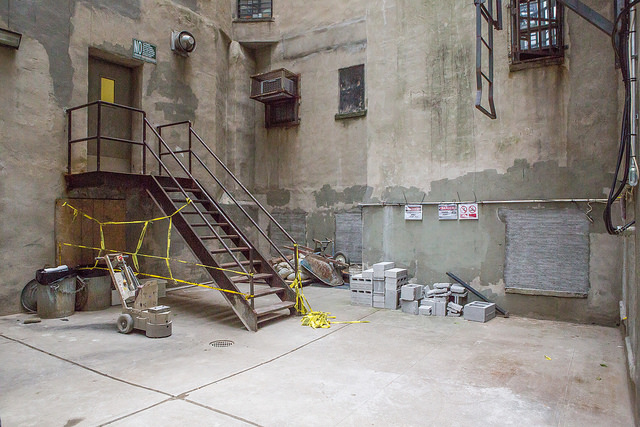Get the Facts Straight on NYCHA Attacks

photo via NYCHA
In a recent op-ed outlining opposition to organized labor and Project Labor Agreements, Associated Buildings & Contractors Empire State Chapter President Brian Sampson paints an outdated and inaccurate picture of NYCHA. Let’s be honest, yes—there had been a long history of mismanagement at NYCHA. But with the new administration and under new leadership, we are taking NYCHA in a different direction that makes old arguments about NYCHA more political than factual.
In the past two years, we’ve taken bold, but necessary steps to fundamentally transform how we do business. The Authority launched NextGeneration NYCHA, our ten-year strategic plan, to transform NYCHA into a modern, more efficient and effective landlord, while also getting our financial house in order. And while there is still work to be done, we are making solid progress through action.
Taxpayer waste was indicative of the old NYCHA. Today, we are committed to transparency as the best form of oversight and accountability of taxpayer dollars. NYCHA now posts work and performance metrics, contracts and awards on our website, and even launched an interactive Sandy Transparency map, where the public can access spending data and status updates on work related to the $3 billion in Federal Emergency Management Agency funding. This digital tool provides information on the scope of work, project phase (planning, design, and construction), estimated funding levels and timelines, renderings and contractor details.
Swipes at NYCHA’s response to Hurricane Sandy or inventory and procurement may score easy political points, but don’t reflect NYCHA’s reality today. NYCHA created the Office of Emergency Preparedness in response to issues raised by Hurricane Sandy, so we are better prepared than we have ever been before. To that end, we issued a report in 2015 outlining our progress.
Additionally, NYCHA has made great strides to overhaul our supply and inventory management process, with a working group composed of independent leadership, supply chain experts, and the city comptroller’s office. Today, inventory is only disposed of after a systematic and thorough analysis. In fact, our reassessment of inventory previously slated for disposal resulted in more than $1 million of materials put back into use.
The nonunion building trades’ real issue with NYCHA isn’t about money or management, it’s about NYCHA’s Project Labor Agreement (PLA.) NYCHA’s PLA, which applies to construction and rehabilitation work, isn’t unique and is widely employed by other city agencies. It allows for greater flexibility in work scheduling and shift hours, and NYCHA is already beginning to see the benefits of the PLA with faster, better, and cost-effective construction work.
This isn’t the first attack by the Associated Builders & Contractors Empire State Chapter and it won’t be the last, but the association should try to stick to the facts on NYCHA. No one is served by rhetoric, especially not NYCHA residents.
***
Michael Kelly is the General Manager of the New York City Housing Authority (NYCHA). On Twitter @NYCHA.
***
Have an op-ed idea or submission for Gotham Gazette? Email This email address is being protected from spambots. You need JavaScript enabled to view it.
Next Steps the State Must Make to Create and Maintain Affordable Housing

photo: a groundbreaking, via the Governor's Office
As the Legislature moves ahead with its 2016 session in Albany, a top priority must be creating and maintaining affordable housing across the state. We cannot be content with fellow New Yorkers sleeping in three-quarter houses, with too many to a room, because it’s the only alternative. It is only so long until the next severely rent burdened tenant - spending more than 50 percent of their earnings on rent - ends up homeless because they cannot afford their apartment.
Governor Cuomo’s State of the State agenda – including 20,000 units of supportive housing over 15 years and 100,000 units of permanent affordable housing - is a welcome first step. Now, there are steps the Legislature should take to spur the development and protection of affordable housing. As President Obama’s call to end chronic homelessness among veterans displays, when government acts and we mobilize on that action, we can address long-term, entrenched issues and ensure individuals have a safe and affordable place to live.
A high priority for Albany should be a new 421-a property tax credit for real estate developers who build affordable housing.
After developers and labor were unable to come to an agreement on construction wages by January 15, the 421-a tax credit expired. Still, Albany can seize the opportunity and craft a new program that maximizes the cost-effective development of truly affordable housing. For example, a new 421-a credit should not include a tax break for condo development. Approximately two-thirds of New York City’s households are renters. Moreover, the median household income of renters in New York City - about $41,000 annually according to the Furman Center’s 2014 State of New York City’s Housing & Neighborhoods - is unlikely enough to afford a co-op or condo.
The Legislature must also adequately fund the 20,000 units of supportive housing announced by Cuomo. In particular, Albany must ensure state contracts with supportive housing providers promote the long-term viability of the units. A consistent challenge that we at Urban Pathways face in operating scattered-site supportive housing - apartments in various private buildings throughout communities - is that the service contracts lack rent escalations. As scattered-site units are in market-rate apartments, they are subject to rent increases, making rent escalation provisions critical to their preservation.
Lastly, after March of this year, the state will receive National Housing Trust Fund dollars. New York will be obligated to spend these funds - potentially $20 million - predominantly on rental housing for extremely low-income (ELI) households. ELI households are those with incomes at or below 30 percent of the area median income (ranging from about $18,150 for a one-person household to $29,500 for a four-person household in New York City). This is another opportunity for the state to invest in adequate exit options for homeless individuals throughout the state.
***
Nicole Bramstedt is the Director of Policy at Urban Pathways, a nonprofit social services and supportive housing organization. On Twitter at @UrbanPathwaysNY
***
Have an op-ed idea or submission for Gotham Gazette? Email This email address is being protected from spambots. You need JavaScript enabled to view it.
Time for NYCHA to Stop Wasting Our Money

photo via NYCHA
In following the news over the past years, it has become readily apparent that the New York City Housing Authority (NYCHA) must either be severely underfunded or grossly mismanaged. Unfortunately it's the latter.
There is no shortage of issues that have come up that demonstrate the ineptitude of NYCHA leadership. From failing to protect residents in advance of Hurricane Sandy to toxic molds to turning on the heat only if it gets to 25 degrees, NYCHA is failing its residents. To say that NYCHA is mismanaged and wasting our tax money is an understatement. Officials are throwing it away, literally - NYCHA actually recently threw away $550,000 of new supplies that were purchased but determined to not be useful.
But wasteful spending doesn't end there. NYCHA attaches Project Labor Agreements (PLAs) to all of their rehab and construction projects. These costly provisions mandate that a vast majority of workers come from the union halls, leading to fewer contractors bidding on the work and diminished competition.
Officials agree to these provisions even though studies show PLAs increase construction costs up to 30 percent. These additional costs come from reduced competition and antiquated jurisdictional work rules that prevent efficiencies. At a time when Mayor de Blasio has taken a stand for increased affordable housing in New York City by standing up to the powerful trades unions and telling them that they've out-priced themselves, NYCHA is acquiescing to their every demand, to the detriment of taxpayers and tenants alike.
An increasing amount of work is being done throughout New York City by merit shop contractors, and with good reason. These men and women have found innovative ways to build the best projects in efficient, cost-effective ways, while still taking great care of their employees. Go to any private job site today and you will more than likely see a diverse group of professionals working together as a team to get the job done. There is no bickering among differing trades as to whose responsibility it is to do key tasks like you see on public or taxpayer funded job sites.
Unfortunately, while these advancements have made construction better and cheaper, our union counterparts have been left behind, instead being forced to rely on their political influence to get publicly funded work such as at NYCHA. But as more and more of the general public is becoming aware of how this impacts their wallets and how much farther their dollar could go, this is changing too.
These changes have spurred the unfortunate rhetoric and baseless claims from union bosses who see their empires slipping away.
Imagine how much work could get done with 30 percent more capital to work with? Maybe those elevators could finally get fixed or the mold would finally be eradicated. Perhaps NYCHA could be more prepared for a disaster. And what if, not to be too bold, NYCHA could actually turn the heat on before it hits 25 degrees?
As a public authority, NYCHA has a fiduciary responsibility to the taxpayers of this city. This should encourage its leaders to stretch tax dollars as far as they can to get the most bang for the buck. They also have a moral obligation to the tenants of their housing. This means they should do everything they can to get the best housing available at the most competitive pricing - making more housing available to those who need it.
NYCHA needs to be cleaned up, and the corruption and mismanagement that have plagued the tenants and taxpayers of New York City needs to be addressed. The process by which NYCHA officials spend hundreds of millions of tax dollars is a start.
Our message to NYCHA is clear: while you've gotten used to throwing our money away, you owe it to taxpayers and tenants to open bids up, create competition, and get the most bang for our buck.
***
Brian Sampson is the President of the Associated Builders and Contractors, Empire State Chapter. The Association was founded on the shared belief that construction projects should be awarded on merit to the most qualified and responsible low bidders. The Chapter represents nearly 400 members in the construction industry throughout NYS.
***
Have an op-ed idea or submission for Gotham Gazette? Email This email address is being protected from spambots. You need JavaScript enabled to view it.




